Climate Beneficial Practices
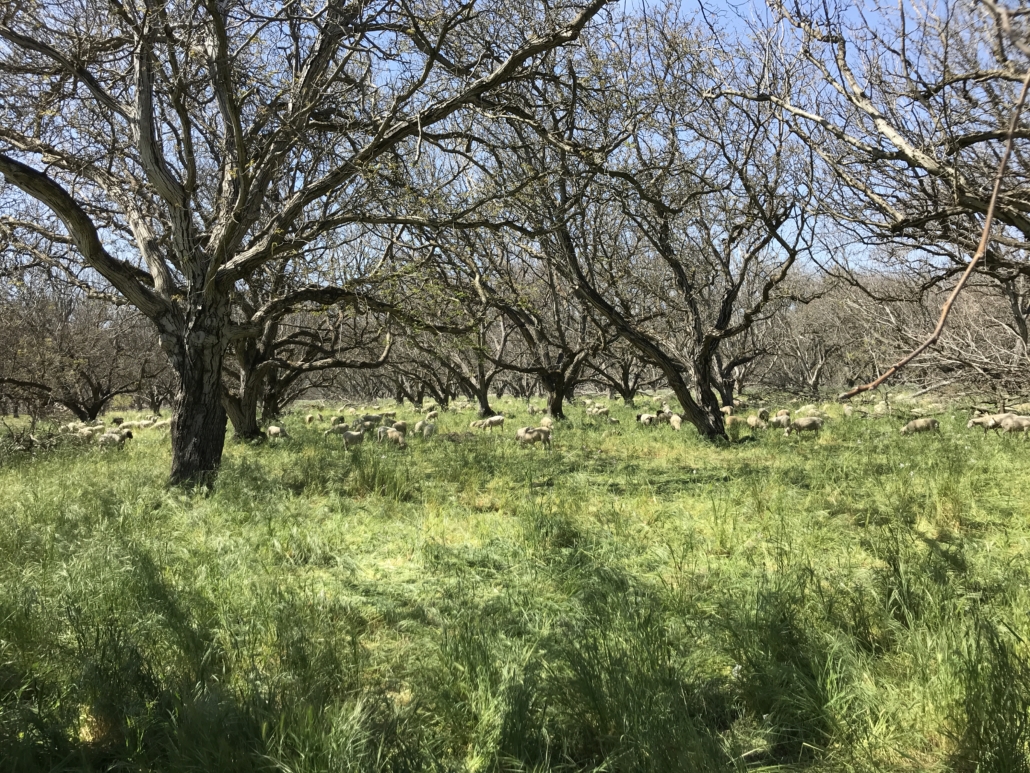
By Katherine Favor, NCAT Sustainable Agriculture Specialist; Mike Lewis, NCAT Sustainable Agriculture Specialist; Lee Rinehart, NCAT Northeast Regional Director; and Elise Haschke, NCAT Climate and Agriculture Program Manager
Contents
Introduction
Forest Farming/Multi-Story Cropping
Forest Gardens/Food Forests
Silvopasture
Wind Breaks/Shelterbelts
Hedgerow Plantings
Riparian Forest Buffers
Tree and Shrub Establishment
Alley Cropping
Field Borders/Other Herbaceous Cover
Contour Buffer Strips
Grassed Waterway
Compost Addition
Cover Cropping
Reduced Till/No-Till
Mulching
Conservation Crop Rotation
Stripcropping
Prescribed Grazing/Holistic Planning Grazing/AMP
Precision Nutrient Management
Introduction
Agricultural practices can benefit the climate by sequestering carbon from the atmosphere and storing it in above-ground biomass or below-ground soil organic matter, and by reducing on-farm emissions of heat-trapping greenhouse gases from a variety of sources, including synthetic fertilizer application, livestock management, and soil respiration.
The following list of climate beneficial practices showcases some of the more common practices that have been scientifically proven to reduce or prevent greenhouse gas (GHG) emissions and/or sequester carbon. There are over 30 NRCS-recognized Climate Smart Agriculture and Forestry conservation practices with quantifiable benefit to the climate. Many of these practices give rise to other ecosystem benefits, such as improving soil health and water quality, restoring natural ecosystems, and promoting biological diversity and agroecosystem resiliency. However, their benefits as specific to mitigating climate change are highlighted here. Research shows that stacking multiple practices has a compounding effect in terms of building soil organic carbon and storing it in healthy soils.
The climate beneficial practices that land stewards choose to implement should be in accordance with their specific growing context; not all of these practices will be appropriate for every growing context. Ideally, various practices will be woven together into a holistic, whole-farm conservation strategy.
Click here for an interactive graphic. Hover over the question mark icons to learn more.

Photo: NCAT
Forest Farming/Multi-Story Cropping
What is it?
Forest farming is the cultivation of a shade-tolerant crop (typically a high-value, specialty crop) under the shade of a forest stand or an orchard (USDA NRCS, 2022).
How is it climate beneficial?
Forest farming prevents CO2 emissions by preserving the carbon stored in the above-ground biomass of natural forest stands, while simultaneously producing an income in the understory. As trees in the forest overstory continue to grow, they continue to sequester CO2 from the atmosphere and turn it into woody biomass (Nilsson and Schopfhauser, 1995).
How much CO2 does it sequester (in tonnes CO2 equivalent per acre per year)?
Forest farming/multi-story cropping can sequester an estimated 18.2 tonnes CO2 equivalent per acre per year, which is equivalent to the amount of gas it takes to drive 45,315 miles in a standard SUV (USDA NRCS, 2022).
Implementation Notes
Choose high-value crops for cultivation under the protection of a managed tree canopy, such as ginseng, goldenseal, shiitake, or other mushrooms.
Related ATTRA Resources
Other Resources
References
Nilsson S. and W. Schopfhauser. 1995. The carbon-sequestration potential of a global afforestation program. Climate Change. Vol. 30. p. 267-293.
USDA NRCS. 2022. Conservation Practice Standard: Forest Farming Code 379.
USDA NRCS. 2022. COMET-Planner.

Photo: NCAT
Forest Gardens/Food Forests
What is it?
Forest gardens or food forests are closed-canopy edible forests consisting of as many as seven vertical layers of edible, medicinal, or otherwise useful plants. They are designed to mimic the structure and function of natural forest stands and can include layers such as the following: an overstory tree layer, an understory tree layer, a shrub layer, a crop layer, a groundcover layer, a vine layer, and a root crop layer (USDA NRCS, 2021).
How is it climate beneficial?
The multiple vertical layers of dense plantings in forest gardens results in maximum concentration of above-ground biomass and root concentration. Carbon is stored in these systems both in the form of above-ground woody biomass and also below-ground roots and organic matter. The density of these plantings allows for maximized carbon storage (Udawatta and Jose, 2012).
How much CO2 does it sequester (in tonnes CO2 equivalent per acre per year)?
Forest gardens/food forests can sequester an estimated 18.2 tonnes CO2 equivalent per acre per year, which is equivalent to the amount of gas it takes to drive 45,315 miles in a standard SUV (USDA NRCS, 2022).
Implementation Notes
Plant a large number of species for optimum diversity, with a primary focus on plants with edible or medicinal uses. It is also beneficial to incorporate plants that provide habitat for wildlife, plants that increase soil fertility (such as legumes), deep rooting plants that can tap mineral sources deep in the subsoil, plants that attract predators of common pests, and plants that provide tree cover and leaf litter to improve nutrient cycling and water infiltration.
Related ATTRA Resources
Other Resources
References
Udawatta, R.P. and S. Jose. 2012. Agroforestry strategies to sequester carbon in temperate North America. Agroforestry Systems. Vol. 86. p. 225-242.
USDA NRCS. 2021. Practice Specification: Multi-Story Cropping (Code 379) and Tree/Shrub Establishment (Code 612) Mixed Agroforest.
USDA/NRCS. 2022. COMET-Planner.

Photo: NCAT
Silvopasture
What is it?
Silvopasture is the intentional integration of livestock, pasture, and trees into a single integrated system, in order to achieve maximum productivity on the land and livestock wellbeing (USDA NRCS, 2016).
How is it climate beneficial?
The tree roots, grass roots, and animal impact of silvopasture systems create the conditions for a thriving soil microbiome, which leads to the rapid drawdown of atmospheric CO2 and below-ground carbon storage in the form of humus. The healthy soil conditions created by silvopasture include increased soil porosity, increased water-holding capacity, an abundance of root litter and root exudates, inoculation from the bacteria in cow manure, and more. Additionally, the woody biomass of trees in silvopasture systems stores above-ground carbon for the duration of the life of the tree. Trees also reduce carbon loss by preventing soil erosion and topsoil loss (Udawatta and Jose, 2012).
How much CO2 does it sequester (in tonnes CO2 equivalent per acre per year)?
Silvopasture can sequester an estimated 13.7 tonnes CO2 equivalent per acre per year, which is equivalent to the amount of gas it takes to drive 34,019 miles in a standard SUV (USDA NRCS, 2022).
Implementation Notes
Establishment can occur by thinning existing overstory forest and planting pasture into it, or by planting new trees into pasture. The pasture component should consist of shade-tolerant pasture, and trees should be spaced to provide 25 to 60% shade.
Related ATTRA Resources
Other Resources
References
USDA NRCS. 2016. Conservation Practice Standard: Silvopasture Code 381.
Udawatta, R.P., and S. Jose. 2012. Agroforestry strategies to sequester carbon in temperate North America. Agroforestry Systems. Vol. 86. p. 225-242.
USDA NRCS. 2022. COMET-Planner.
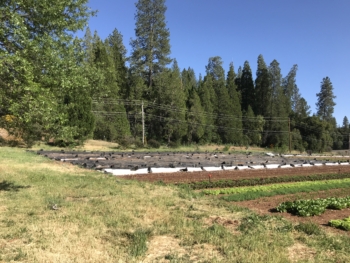
Photo: NCAT
Windbreaks / Shelterbelts
What is it?
Windbreaks are linear plantings of trees and shrubs in one to three rows on the edges of fields, designed to reduce wind, evenly distribute snowfall, prevent pesticide drift, and provide natural habitat (USDA NRCS, 2021).
How is it climate beneficial?
Windbreaks prevent carbon loss from the soil by reducing wind erosion and subsequent topsoil loss. Tree roots also increase below-ground carbon storage in the form of organic matter by improving the conditions for the soil microbiome to thrive in, such as providing a source of carbon and nutrients through tree root litter and exudates, increasing soil porosity, and increasing infiltration and water- holding capacity. Additionally, the woody biomass of trees in windbreaks stores carbon in the form of above-ground biomass for the duration of the life of the tree (Udawatta and Jose, 2012).
How much CO2 does it sequester (in tonnes CO2 equivalent per acre per year)?
Windbreaks and shelterbelts can sequester an estimated 9.2 tonnes CO2 equivalent per acre per year, which is equivalent to the amount of gas it takes to drive 22,849 miles in a standard SUV (USDA NRCS, 2022).
Implementation Notes
Plant one to three rows of trees perpendicular to prevailing winds. Use Wind Rose datasets to determine prevailing wind direction. The windbreak length should be at least 10 times the height of the trees, and trees should be spaced so that there is 40 to 60% foliage density. It is critical that there are no gaps in vegetation for the windbreak to be functional.
Related ATTRA Resources
Other Resources
References
USDA NRCS. 2021. Conservation Practice Standard: Windbreak-Shelterbelt Establishment and Renovation Code 380.
Udawatta, R.P. and S. Jose. 2012. Agroforestry strategies to sequester carbon in temperate North America. Agroforestry Systems. Vol. 86. p. 225-242.
USDA NRCS. 2022. COMET-Planner.
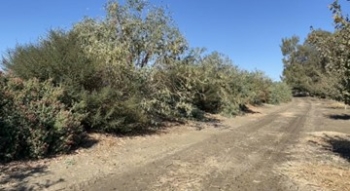
Photo: NCAT
Hedgerow Plantings
What is it?
Hedgerows are strips of native or naturalized perennial trees, shrubs, and forbs planted on field edges to provide habitat for wildlife and beneficial insects, reduce wind, and help store carbon (USDA NRCS, 2010).
How is it climate beneficial?
The woody perennials in hedgerow plantings store carbon in the form of above-ground biomass for the duration of the life of the tree or shrub (Chiartas et al., 2022).
How much CO2 does it sequester (in tonnes CO2 equivalent per acre per year)?
Hedgerow plantings can sequester an estimated 7.2 tonnes CO2 equivalent per acre per year, which is equivalent to the amount of gas it takes to drive 17,758 miles in a standard SUV (USDA NRCS, 2022).
Implementation Notes
One to three rows of plants are ideal for hedgerow plantings. Select native trees and shrubs that flower at varying times of the year to support the widest variety of wildlife, pollinators, and other beneficial insects. Reserve at least one-half acre for every 40 acres to plant in crops for pollinators.
Related ATTRA Resources
Conservation Buffers in Organic Systems
Conservation Hedgerows for the Southwest
Other Resources
A Guide to Hedgerows: Plantings That Enhance Biodiversity, Sustainability and Functionality
References
USDA NRCS. 2010. Conservation Practice Standard: Hedgerow Planting Code 422.
Chiartas, J., L.E. Jackson, R.F. Long, A. Margenot, and A.T. O’Geen. 2022. Hedgerows on Crop Field Edges Increase Soil Carbon to a Depth of 1 Meter. Sustainability. Vol. 14, No. 19: 12901.
USDA/NRCS. 2022. COMET-Planner.
Riparian Forest Buffers
What is it?
Riparian forest buffers are bands of trees, shrubs, forbs, and grasses at different widths along streambanks and waterways (USDA NRCS, 2020).
How is it climate beneficial?
Riparian forest buffers reduce soil carbon loss by preventing erosion and topsoil loss. Additionally, tree, forb, and grass roots improve soil porosity and water-holding capacity and provide root litter and exudates to stimulate the soil microbiome, leading to increased organic matter and below-ground carbon storage. The woody biomass of trees and shrubs in riparian forest buffers also stores carbon in the form of above-ground biomass for the duration of the life of the tree (Udawatta and Jose, 2012).
How much CO2 does it sequester (in tonnes CO2 equivalent per acre per year)?
Riparian forest buffers can sequester an estimated 6.37 tonnes CO2 equivalent per acre per year, which is equivalent to the amount of gas it takes to drive 15,807 miles in a standard SUV (USDA NRCS 2022).
Implementation Notes
Design buffer width based on your goals, whether they be pollution removal, sediment filtration, or wildlife habitat. Other factors that should be considered in the design are field length, slope, soil texture, pollutant type, and C-factor (based on the Universal Soil Loss Equation and determined by floor management practice employed).
Related ATTRA Resources
Other Resources
References
Udawatta, R.P., and S. Jose. 2012. Agroforestry strategies to sequester carbon in temperate North America. Agroforestry Systems. Vol. 86. p. 225-242.
USDA NRCS. 2020. Conservation Practice Standard: Riparian Forest Buffer Code 391.
USDA NRCS. 2022. COMET-Planner.
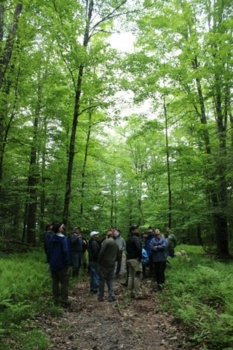
Photo: NCAT
Tree and Shrub Establishment
What is it?
The establishment of woody trees and shrubs helps preserve land and maintain it as an undisturbed natural area for improved wildlife habitat, water quality, and carbon sequestration (USDA NRCS, 2017).
How is it climate beneficial?
Woody vegetation sequesters atmospheric CO2 and converts it into both above-ground carbon in the form of woody biomass and below-ground carbon in the form of humus (Nilson and Schopfhauser, 1995; Forster et al., 2021).
How much CO2 does it sequester (in tonnes CO2 equivalent per acre per year)?
Tree/shrub establishment can sequester an estimated 1.76 tonnes CO2 equivalent per acre per year, which is equivalent to the amount of gas it takes to drive 4,344 miles in a standard SUV (USDA NRCS, 2022).
Implementation Notes
Four principles for afforestation are:
- Plantings should enhance local economies.
- Plantings should not replace native ecosystems.
- Plantings should promote landscape heterogeneity and biological diversity.
- Plantings should show a distinction in monitoring between residual carbon stocks and newly established carbon stocks.
Related ATTRA Resources
Episode 158. Conservation Easements and Ecosystem Service Markets
References
Forster E.J., J.R. Healey, C. Dymond, and D. Styles. 2021. Commercial afforestation can deliver effective climate change mitigation under multiple decarbonisation pathways. Nature Communications. Vol. 12, No. 3831.
Nilsson S., and W. SchopfhauserW. 1995. The carbon-sequestration potential of a global afforestation program. Climate Change. Vol. 30. p. 267-293.
USDA NRCS. November 2017. Conservation Practice Standard: Tree/Shrub Establishment Code 612.
USDA NRCS. 2022. COMET-Planner.
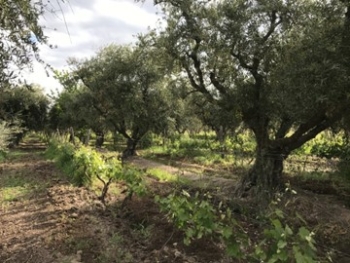
Photo: NCAT
Alley Cropping
What is it?
Alley cropping is the practice of intercropping rows of crops with rows of trees to maximize production and sustainability (USDA NRCS, 2017).
How is it climate beneficial?
The trees in alley-cropping systems store a large amount of carbon in an above-ground form, as woody biomass that keeps carbon in a solid form for the duration of the life of the tree. Alley cropping also reduces carbon loss from the soil by preventing erosion and topsoil loss. The trees in alley-cropping systems encourage rapid organic matter production by creating the soil conditions necessary for soil microbiology to thrive, such as increasing soil porosity, increasing water holding capacity, and providing an abundant source of root exudates and litter to stimulate the soil microbiome, which all lead to increased organic matter production and below-ground carbon storage (Udawatta and Jose, 2012).
How much CO2 does it sequester (in tonnes CO2 equivalent per acre per year)?
Alley cropping can sequester an estimated 1.37 tonnes CO2 equivalent per acre per year, which is equivalent to the amount of gas it takes to drive 3,401 miles in a standard SUV (USDA NRCS, 2022).
Implementation Notes
The tree and crop species should be adapted to the soils, climate, and site. Species and spacing should ensure accessibility for spraying, pruning, or harvesting. Care should be taken to choose tree and crop species that are compatible with each other and that will not overly compete for water, nutrients, and light. Good design and an intensive and consistent management strategy are critical for the success of alley-cropping systems.
Related ATTRA Resources
Designing a Coffee and Avocado Alley Cropping System
Further Resources
References
Udawatta, R.P. and S. Jose. 2012. Agroforestry strategies to sequester carbon in temperate North America. Agroforestry Systems. Vol. 86. p. 225-242.
USDA NRCS. 2017. Conservation Practice Standard: Alley Cropping Code 311.
USDA NRCS. 2022. COMET-Planner.
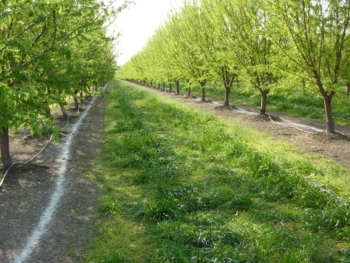
Photo: NCAT
Field Borders/Other Herbaceous Cover
What is it?
Field borders are bands of perennial vegetation (typically 20 feet wide or more) on the edges of crop fields that sequester CO2 from the atmosphere while increasing plant diversity and providing habitat for beneficial insects and wildlife, filtering agrochemicals and toxins before they reach water, and reducing erosion (USDA NRCS, 2016).
Field borders are one of several practices that establish permanent vegetation by converting cropland to herbaceous cover. Additional practices include Conservation Cover, Vegetative Barrier, Filter Strips, and Herbaceous Wind Barrier.
How is it climate beneficial?
Permanent herbaceous cover sequesters atmospheric carbon in above-ground biomass and stores it in the soil through continuous living roots (Chartin et al., 2013). It also reduces soil erosion, helping to keep carbon in the soil.
How much CO2 does it sequester (in tonnes CO2 equivalent per acre per year)?
Field borders and other herbaceous cover can sequester an estimated 1.26 tonnes CO2 equivalent per acre, per year, which is equivalent to the amount of gas it takes to drive 3,128 miles in a standard SUV (USDA NRCS, 2022).
Implementation Notes
Field borders should be as wide as possible for optimum benefit. Borders of 15 to 30 feet are common. Ideally, field borders should surround the entire crop field, connect fallow corners, and provide connectivity with undisturbed areas (woods, riparian areas, etc.).
Other Resources
Field Borders for Agronomic, Economic and Wildlife Benefits
References
Chartin, C., O. Evrard, S. Salvador-Blanes, F. Hinschberger, K. Van Oost., I. Lefevre, J. Daroussin, and J.J. Macaire. 2013. Quantifying and modelling the impact of land consolidation and field borders on soil redistribution in agricultural landscapes (1954-2009). Catena. Vol. 110. p. 184-195.
USDA/NRCS. September 2016. Conservation Practice Standard: Field Border Code 386.
USDA/NRCS. 2022. COMET-Planner.
Contour Buffer Strips
What is it?
Contour buffer strips are strips of perennial vegetation planted in horizontal bands on contour, perpendicular to the slope of the land, in order to stabilize the soil and prevent erosion (USDA NRCS, 2014).
How is it climate beneficial?
Contour buffer strips reduce erosion and runoff, leading to reduced topsoil loss and more organic matter (carbon) staying in the soil (Bailey et al., 2009). Perennial vegetation also drives greater photosynthetic conversion of atmospheric CO2 into above-ground biomass and below-ground organic carbon.
How much CO2 does it sequester (in tonnes CO2 equivalent per acre per year)?
Contour buffer strips can sequester an estimated 1.12 tonnes CO2 equivalent per acre, per year, which is equivalent to the amount of gas it takes to drive 2,892 miles in a standard SUV (USDA NRCS, 2022).
Implementation Notes
Buffer strip rows should have a maximum grade of 1/2%. The width should be no less than 15 feet for grasses or grass/legume mixtures and no less than 30 feet when legumes are used alone.
References
Bailey, N.J., P.P. Motavalli, R.P. Udawatta, and K.A. Nelson. Soil CO2 emissions in agricultural watersheds with agroforestry and grass contour buffer strips. Agroforestry Systems. Vol. 77. p. 143-158.
USDA NRCS. September 2014. Conservation Practice Standard: Contour Buffer Strips.
USDA NRCS. 2022. COMET-Planner.
Grassed Waterway
What is it?
Grassed waterways are plantings of grass on sloped channels where erosion and runoff would otherwise occur if the soil were left bare (USDA NRCS, 2020).
How is it climate beneficial?
Grassed waterways prevent the removal of soil organic carbon from a farm by catching eroded organic matter from adjacent fields and storing it in place, serving as a carbon sink. Grass also photosynthesizes and converts atmospheric CO2 into above- and below-ground biomass, which will eventually turn into stable humus (Wilken et al., 2017).
How much CO2 does it sequester (in tonnes CO2 equivalent per acre per year)?
Grassed waterways can sequester an estimated 0.84 tonnes CO2 equivalent per acre, per year, which is equivalent to the amount of gas it takes to drive 2,089 miles in a standard SUV (USDA NRCS, 2022).
Implementation Notes
A grassed waterway should direct water and prevent it from becoming channelized, without eroding the soil. To establish a grassed waterway, the soil surface should be smooth to allow for grass germination and to prevent flow disruptions. Waterways should be directed to a common channel.
Other Resources
Grassed Waterway Design – Illinois Drainage Guide
References
USDA NRCS. September 2020. Conservation Practice Standard: Grassed Waterway Code 412.
USDA NRCS. 2022. COMET-Planner.
Wilken, F., M. Sommer, K. Van Oost., O. Bens, and P. Fiener. 2017. Process-oriented modelling to identify main drivers of erosion-induced carbon fluxes. Soil. Vol. 3. p. 83-94.
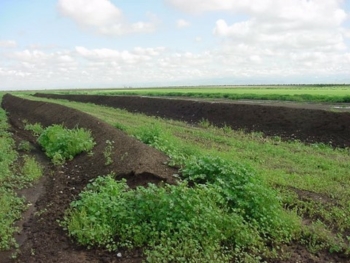
Photo: NCAT
Compost Addition
What is it?
Compost is decayed organic matter applied to soil as an organic fertilizer that provides plants with plant-available nutrients. When compost is used instead of synthetic fertilizer, it can benefit the climate in numerous ways (USDA NRCS, 2021).
How is it climate beneficial?
Using compost in place of synthetic fertilizer prevents the release of nitrous oxide, an especially potent greenhouse gas that is often a result of the overapplication of synthetic fertilizer. Compost is a carbon-rich soil amendment that directly adds carbon into the agroecosystem. Additionally, the nutrients from compost are plant-available and microbe-available, helping to rapidly increase the population of soil microbes, which allows for the conversion of organic matter into stable humus in a shorter amount of time (Tautges et al., 2019; California Air Resources Board, 2017).
How much CO2 does it sequester (in tonnes CO2 equivalent per acre per year)?
Compost can sequester an estimated 0.75 tonnes CO2 equivalent per acre, per year, which is equivalent to the amount of gas it takes to drive 1,862 miles in a standard SUV (USDA NRCS, 2022).
Implementation Notes
Compost application rates can be calculated using fertilizer recommendations from soil tests and compost nutrient analysis. General guidelines suggest that 10% to 25% of compost N will be plant-available during the first year of application. Care should be taken to not over-apply compost.
Related ATTRA Resources
References
California Air Resources Board. 2017. Quantification of Greenhouse Gas Emissions for Compost Application in California Croplands. Research Division, Transportation and Toxics Division.
Tautges, N.E., J.L. Chiartas, A.C.M. Gaudin, A.T. O’Geen, I. Herrera, and K.M. Scow. 2019. Deep soil inventories reveal that impacts of cover crops and compost on soil carbon sequestration differ in surface and subsurface soils. Global Change Biology. Vol. 25, No. 11. p. 3753-3766.
USDA NRCS. August 2021. Conservation Practice Standard: Soil Carbon Amendment Code 808.
USDA/NRCS. 2022. COMET-Planner.
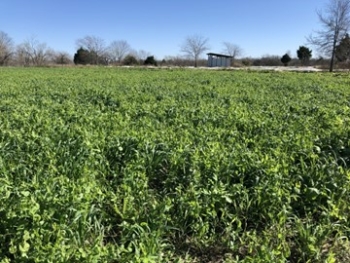
Photo: NCAT
Cover Cropping
What is it?
Cover cropping is the practice of planting mixes of non-invasive grasses, legumes, and forbs as seasonal vegetative cover on the soil, instead of leaving the soil bare (USDA NRCS, 2014).
How is it climate beneficial?
Planting cover crops during the fallow season puts photosynthesizing plants onto ground that would have otherwise been bare. Through the process of photosynthesis, CO2 in the air turns into solid CO2 in plant biomass, and eventually into solid CO2 in the form of humus (Zhang et al., 2022; Blanco-Canqui, 2022). Cover crops reduce soil erosion, minimize soil compaction, and increase soil porosity—all of which lead to improved microbiome health and rapid creation and maintenance of organic matter.
How much CO2 does it sequester (in tonnes CO2 equivalent per acre per year)?
Cover cropping can sequester an estimated 0.64 tonnes CO2 equivalent per acre, per year, which is equivalent to the amount of gas it takes to drive 1,597 miles in a standard SUV (USDA NRCS, 2022).
Implementation Notes
Soil organic carbon accumulation from cover crops is variable and should be combined with crop rotations and other practices to achieve optimum carbon sequestration. An ideal cover crop mix will include grasses, forbs, and legumes. Cover crop species should be selected based on your goals for the field, and can include goals such as nitrogen fixation, compaction reduction, erosion control, residue production, weed suppression, nematode control, and more.
Related ATTRA Resources
References
Blanco-Canqui, H. 2022. Cover crops and carbon sequestration: Lessons from U.S. studies. Soil Science Society of America Journal. Vol. 86, No. 3. p. 501-519.
USDA NRCS. 2014. Conservation Practice Standard: Cover Crop Code 340.
USDA NRCS. 2022. COMET-Planner.
Zhang Z., J.P. Kaye, B.A. Bradley, J.P. Amsili, and V. Suseela. 2022. Cover crop functional types differentially alter the content and composition of soil organic carbon in particulate and mineral-associated fractions. Global Change Biology. Vol. 28. p. 5831-5848.
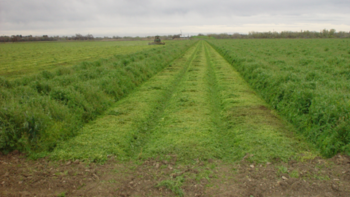
Photo: NCAT
Reduced Till/No-Till
What is it?
The conservation tillage techniques of reduced till and no-till/strip-till cultivate soil in a way that minimally disturbs the underground soil microbiome by leaving at least 30% of the soil surface covered in crop or cover crop residue and reducing the number of equipment passes and soil compaction in the fields (USDA NRCS, 2016).
How is it climate beneficial?
No-till and reduced till minimize soil oxidation and respiration, which releases CO2 from the soil and into the atmosphere. Conservation tillage also maintains soil aggregate stability and can reduce carbon losses through topsoil erosion. Conservation tillage allows for the rapid accrual of soil organic carbon and creation of soil organic matter by leaving the soil microbiome undisturbed and by maintaining conditions critical to microbiome health, such as available plant moisture and root exudates that remain in the soil. Leaving crop residues on fields allows them to break down in place, replenishing nutrients in the field and enhancing a healthy soil microbiome. Conservation tillage can also reduce energy use, thereby reducing CO2 emissions, as less fuel is consumed when less soil is disturbed. (Lal and Kimble, 1997; Wang et al., 2020).
How much CO2 does it sequester (in tonnes CO2 equivalent per acre per year)?
No-till and minimal tillage can sequester an estimated 0.45 tonnes CO2 equivalent per acre, per year, which is equivalent to the amount of gas it takes to drive 1,117 miles in a standard SUV (USDA NRCS, 2022).
Implementation Notes
Start planning at least one year before implementation with a good fertility and weed-management plan. A good entry point for minimal tillage or no-till is after having planted a cover crop.
Related ATTRA Resources
Managing Soils for Water: How Five Principles of Soil Health Support Water Infiltration and Storage
References
Lal, R., and J.M. Kimble. 1997. Conservation tillage for carbon sequestration. Nutrient Cycling in Agroecosystems. Vol. 49. p. 243-253.
USDA NRCS. 2016. Residue and Tillage Management, No-Till (Ac.) (329) Conservation Practice Standard.
USDA NRCS. 2022. COMET-Planner.
Wang, H., S. Wang, Q. Yu, Y. Zhang, R. Wang, J. Li, and X. Wang. 2020. No tillage increases soil organic carbon storage and decreases carbon dioxide emission in the crop residue-returned farming system. Journal of Environmental Management. Vol. 261, No. 110261.
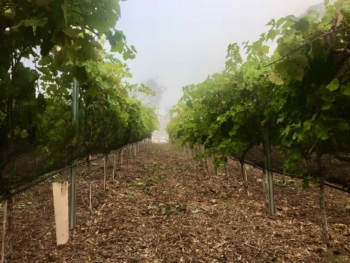
Photo: NCAT
Mulching
What is it?
Mulching is the application of woody and carbon-rich plant residues, such as wood chips, to the soil surface to prevent erosion and build soil health (USDA NRCS, 2017).
How is it climate beneficial?
Mulching with woody residues reduces carbon loss from the soil by reducing erosion and topsoil loss. Mulching also helps maintain soil moisture and provides a source of food to sustain a healthy soil microbiome, thus stimulating the rapid production of humus (Singh et al., 2013).
How much CO2 does it sequester (in tonnes CO2 equivalent per acre per year)?
Mulching can sequester an estimated 0.28 tonnes CO2 equivalent per acre, per year, which is equivalent to the amount of gas it takes to drive 703 miles in a standard SUV (NRCS USDA, 2022).
Implementation Notes
When mulch is first applied, microbial decomposition may reduce available N in the soil. Reduce this impact by using diverse crop rotations, keeping the soil covered, and integrating cover crops.
Related ATTRA Resources
References
Singh Kahlon, M., R. Lal, and M. Ann-Varughese. 2013. Twenty-two years of tillage and mulching impacts on soil physical characteristics and carbon sequestration in Central Ohio. Soil and Tillage Research. Vol. 126. p. 151-158.
USDA NRCS. October 2017. Conservation Practice Standard: Mulching Code 484.
USDA-NRCS. 2022. COMET-Planner.
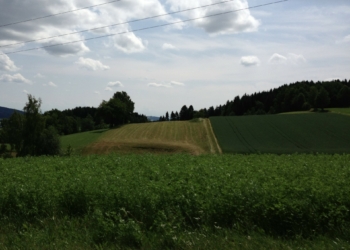
Photo: NCAT
Conservation Crop Rotation
What is it?
Conservation crop rotation is the practice of growing different crops on the same land in a sequential rotation over time, to improve soil health and reduce pest pressure (USDA NRCS, 2014).
How is it climate beneficial?
Planting different crops one after another replenishes soil nutrients, which keeps the soil microbiome balanced and healthy, leading to rapid creation of organic matter and humus (West and Post, 2002).
How much CO2 does it sequester (in tonnes CO2 equivalent per acre per year)?
Conservation crop rotation can sequester an estimated 0.23 tonnes CO2 equivalent per acre, per year, which is equivalent to the amount of gas it takes to drive 571 miles in a standard SUV (USDA NRCS, 2022).
Implementation Notes
A crop rotation plan that includes cash crops, sod, cover crops, green manure crops, and catch crops helps improve soil organic matter content, encourage beneficial insect populations, manage deficient or excess plant nutrients, and control erosion.
Related ATTRA Resources
Tipsheet: Crop Rotation in Organic Farming Systems
Other Resources
Crop Rotation on Organic Farms
References
USDA NRCS. 2014. Conservation Practice Standard: Conservation Crop Rotation Code 328.
USDA NRCS. 2022. COMET-Planner. www.comet-planner.com
West, T.O., and W.M. Post. 2002. Soil Organic Carbon Sequestration Rates by Tillage and Crop Rotation: A Global Data Analysis. Soil Science Society of America Journal. Vol. 66, No. 6, p. 1930-1946.

Photo: NCAT
Stripcropping
What is it?
Stripcropping, also referred to as intercropping, involves planting a diversity of crops on the same land in alternating strips of crops susceptible to erosion with strips of erosion-resistant crops or cover to reduce erosion, prevent water contamination and improve plant health and productivity. (USDA NRCS, 2017).
How is it climate beneficial?
Producing a diversity of complementary plants on the same land increases soil health and whole-farm productivity, resulting in greater below-ground biomass, subsequent higher root litter and, ultimately, higher soil organic carbon (Cong et al., 2014). Among agroecological elements, biological diversification on farms consistently has strong positive climate change adaptation and mitigation impacts and can also attract beneficial insects for improved pest control.
How much CO2 does it sequester (in tonnes CO2 equivalent per acre per year)?
Stripcropping can sequester an estimated 0.21 tonnes CO2 equivalent per acre per year, which is equivalent to the amount of gas it takes to drive 521 miles in a standard SUV (USDA NRCS, 2022).
Implementation Notes
At least 50% of the rotation must be in erosion-resistant crops or sediment-trapping cover. To improve cropping system diversity and associated benefits, consider growing crops, forages, specialty crops, or cover crops in a planned rotation in the stripcropping arrangement.
Related ATTRA Resources
Companion Planting & Botanical Pesticides: Concepts & Resources
Other Resources
Intercropping Legumes with Nonlegumes
References
Cong, W-F., E. Hoffland, L. Li, J. Six, J-H. Sun, X-G. Bao, F-S. Zhang, and W. Van Der Werf. 2014. Intercropping enhances soil carbon and nitrogen. Global Change Biology. Vol. 21, No. 4, p. 1715-1726.
USDA NRCS. 2017. Conservation Practice Standard: Stripcropping Code 585.
USDA NRCS. 2022. COMET-Planner.
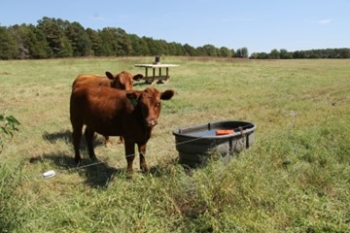
Photo: NCAT
Prescribed Grazing/Holistic Planned Grazing / AMP
What is it?
This practice has been called by many different terms, but all terms refer to the practice of moving animals in a way that mimics nature and that allows for the maximum, sustainable production of pasture and soil health (USDA NRCS, 2017).
How is it climate beneficial?
Holistic planned grazing encourages maximum production of photosynthesizing grass, which sequesters more greenhouse gases from the air than grazing cattle emit. Holistic planned grazing also encourages a healthy soil microbiome, which results in the rapid conversion of organic matter into stable humus. In fire-prone areas, holistic planned grazing can reduce fuel loads, thus preventing the release of CO2 into the atmosphere through burning (Mosier et al., 2021).
How much CO2 does it sequester (in tonnes CO2 equivalent per acre per year)?
Holistic planned grazing can sequester an estimated 0.13 tonnes CO2 equivalent per acre, per year, which is equivalent to the amount of gas it takes to drive331 miles in a standard SUV (USDA NRCS, 2022).
Implementation Notes
Carbon gains with grazing are possible but variable. Cropland returned to perennial meadows seems to be the most probable driver for carbon sequestration, but rates will level out over time.
Related ATTRA Resources
Pasture, Rangeland, and Adaptive Grazing
References
Mosier, S., S.I. Apfelbaum, P. Byck, F. Calderon, W.R. Teague, R. Thompsom, and M.F. Cotrufo. 2021. Adaptive multi-paddock grazing enhances soil carbon and nitrogen stocks and stabilization through mineral association in southeastern U.S. grazing lands. Journal of Environmental Management. Vol. 308, No. 114576.
USDA NRCS. 2017. Conservation Practice Standard: Prescribed Grazing Code 528.
USDA NRCS. 2022. COMET-Planner.
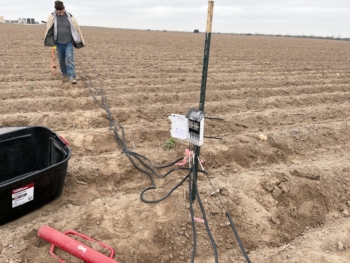
Photo: NCAT
Precision Nutrient Management
What is it?
Precision nutrient management is the application of nutrients (whether in the form of manure, compost, biologically fixed N, or chemical fertilizers) to the ground from the right source, at the right rate, at the right time, and at the right place to maximize efficiency and minimize excess. With precision nutrient management, producers can expect to use at least 15% less fertilizer (USDA NRCS, 2019).
How is it climate beneficial?
When nitrogen is applied in excess to a field, it can result in the release of the greenhouse gas nitrous oxide. Precision nutrient management prevents excess nitrogen applications, thereby preventing nitrous oxide release. Additionally, by reducing the amount of chemical fertilizer applied to farms, precision nutrient management also minimizes the negative effects of chemical fertilizers on soil biology, leading to healthier soil microbiomes and the increased production of humus (Kumar et al., 2020).
How much CO2 does it sequester (in tonnes CO2 equivalent per acre per year)?
Precision nutrient management can sequester an estimated 0.013 tonnes CO2 equivalent per acre, per year, which is equivalent to the amount of gas it takes to drive 32.3 miles in a standard SUV (USDA NRCS, 2022).
Implementation Notes
Precision nutrient management requires a nutrient budget that includes each nutrient applied from all sources, including synthetic fertilizers, pesticides, animal manures, other organic amendments, and irrigation water. The budget is the nutrient application prescription used to apply the nutrients. The budget includes application maps for each nutrient, specifically N, P, and K.
Other Resources
Nutrient Management and Precision Application Technology. 2022. Climate Learning Network.
References
Kumar, A., R. Singh, S. Babu, R. Avasthe, B. Gudade, G. Gupta, G. Verma. 2020. Precision Nutrient Management in Conservation Agriculture. Just Agriculture. Vol. 2, p. 70-77.
USDA NRCS. 2019. Conservation Practice Standard: Nutrient Management Code 590.
USDA NRCS. 2022. COMET-Planner.
Disclaimer: These greenhouse-gas benefit estimates in this publication are taken from COMET-Planner data averaged across six U.S. regions: Northeast, Southeast, Midwest, Southwest, Pacific Northwest, and California’s Central Valley. Greenhouse-gas benefits on individual farms and ranches will vary depending on a variety of factors, such as, but not limited to, soil type, crops grown, land use, and irrigation. Visit COMET-planner.com to find estimates for your county and operation-specific management practices.

